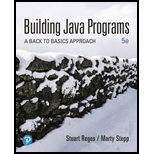
Rearrange stack of integers
Program plan:
- Import necessary packages.
- Create a class “StackSplit”,
- Define the method “splitstack ()” that accepts stack of integers,
- Construct “LinkedList” object.
- Calculate the stack size.
- Execute till stack is empty,
- Transfer all the stack elements from stack to queue.
- Execute loop till the stack size,
- Assign the element removed from the queue to the variable.
- Check whether the element is negative,
- Insert the element into the stack.
-
- Otherwise,
- Insert the element into the queue.
- Otherwise,
- Execute till queue is empty,
- Transfer non-negative integers from queue to stack.
- Print stack of integers after rearranged.
- Define the method “main()”,
- Create object for “Stack”.
- Add integers into the stack.
- Print the stack of integers.
- Call the method “splitStack()” with stack as parameter.
- Define the method “splitstack ()” that accepts stack of integers,
This program demonstrates the method that accepts a stack of integers and rearranges its elements.
Explanation of Solution
Program:
File name: “StackSplit.java”
//Import necessary packages
import java.util.LinkedList;
import java.util.Queue;
import java.util.Stack;
//Create a class
class StackSplit
{
//Define the method
public static void splitStack(Stack<Integer> s)
{
//Construct LinkedList object
Queue<Integer> q1 = new LinkedList<Integer>();
//Calculate the stack size
int old_Length = s.size();
//Execute till stack is empty
while (!s.isEmpty())
{
//Transfer all elements from stack to queue
q1.add(s.pop());
}
//Execute till the stack size
for (int i = 1; i <= old_Length; i++)
{
//Assign the element removed from the queue
int n1 = q1.remove();
//check whether the element is negative
if (n1 < 0)
{
//Insert the element into the stack
s.push(n1);
}
else
{
//Insert the element into the queue
q1.add(n1);
}
}
//Execute till queue is empty
while (!q1.isEmpty())
{
/*Transfer non-negative integers from queue to stack*/
s.push(q1.remove());
}
//Print stack of integers
System.out.println("The elements of a stack of integers after rearranged: "+s);
}
//Define the main() method
public static void main(String[] args)
{
//Create object for Stack
Stack<Integer> s1=new Stack<Integer>();
//Add the integers into the stack
s1.push(3);
s1.push(-5);
s1.push(1);
s1.push(2);
s1.push(-4);
//Print the stack of integers
System.out.println("The elements of a stack of integers: "+s1);
//Call the method
splitStack(s1);
}
}
Output:
The elements of a stack of integers: [3, -5, 1, 2, -4]
The elements of a stack of integers after rearranged: [-4, -5, 2, 1, 3]
Want to see more full solutions like this?
Chapter 14 Solutions
Building Java Programs: A Back To Basics Approach, Loose Leaf Edition (5th Edition)
- Show all the workarrow_forwardShow all the workarrow_forward[5 marks] Give a recursive definition for the language anb2n where n = 1, 2, 3, ... over the alphabet Ó={a, b}. 2) [12 marks] Consider the following languages over the alphabet ={a ,b}, (i) The language of all words that begin and end an a (ii) The language where every a in a word is immediately followed by at least one b. (a) Express each as a Regular Expression (b) Draw an FA for each language (c) For Language (i), draw a TG using at most 3 states (d) For Language (ii), construct a CFG.arrow_forward
- Question 1 Generate a random sample of standard lognormal data (rlnorm()) for sample size n = 100. Construct histogram estimates of density for this sample using Sturges’ Rule, Scott’s Normal Reference Rule, and the FD Rule. Question 2 Construct a frequency polygon density estimate for the sample in Question 1, using bin width determined by Sturges’ Rule.arrow_forwardGenerate a random sample of standard lognormal data (rlnorm()) for sample size n = 100. Construct histogram estimates of density for this sample using Sturges’ Rule, Scott’s Normal Reference Rule, and the FD Rule.arrow_forwardCan I get help with this case please, thank youarrow_forward
- I need help to solve the following, thank youarrow_forwardreminder it an exercice not a grading work GETTING STARTED Open the file SC_EX19_EOM2-1_FirstLastNamexlsx, available for download from the SAM website. Save the file as SC_EX19_EOM2-1_FirstLastNamexlsx by changing the “1” to a “2”. If you do not see the .xlsx file extension in the Save As dialog box, do not type it. The program will add the file extension for you automatically. With the file SC_EX19_EOM2-1_FirstLastNamexlsx still open, ensure that your first and last name is displayed in cell B6 of the Documentation sheet. If cell B6 does not display your name, delete the file and download a new copy from the SAM website. Brad Kauffman is the senior director of projects for Rivera Engineering in Miami, Florida. The company performs engineering projects for public utilities and energy companies. Brad has started to create an Excel workbook to track estimated and actual hours and billing amounts for each project. He asks you to format the workbook to make the…arrow_forwardNeed help completing this algorithm here in coding! 2arrow_forward
 Database System ConceptsComputer ScienceISBN:9780078022159Author:Abraham Silberschatz Professor, Henry F. Korth, S. SudarshanPublisher:McGraw-Hill Education
Database System ConceptsComputer ScienceISBN:9780078022159Author:Abraham Silberschatz Professor, Henry F. Korth, S. SudarshanPublisher:McGraw-Hill Education Starting Out with Python (4th Edition)Computer ScienceISBN:9780134444321Author:Tony GaddisPublisher:PEARSON
Starting Out with Python (4th Edition)Computer ScienceISBN:9780134444321Author:Tony GaddisPublisher:PEARSON Digital Fundamentals (11th Edition)Computer ScienceISBN:9780132737968Author:Thomas L. FloydPublisher:PEARSON
Digital Fundamentals (11th Edition)Computer ScienceISBN:9780132737968Author:Thomas L. FloydPublisher:PEARSON C How to Program (8th Edition)Computer ScienceISBN:9780133976892Author:Paul J. Deitel, Harvey DeitelPublisher:PEARSON
C How to Program (8th Edition)Computer ScienceISBN:9780133976892Author:Paul J. Deitel, Harvey DeitelPublisher:PEARSON Database Systems: Design, Implementation, & Manag...Computer ScienceISBN:9781337627900Author:Carlos Coronel, Steven MorrisPublisher:Cengage Learning
Database Systems: Design, Implementation, & Manag...Computer ScienceISBN:9781337627900Author:Carlos Coronel, Steven MorrisPublisher:Cengage Learning Programmable Logic ControllersComputer ScienceISBN:9780073373843Author:Frank D. PetruzellaPublisher:McGraw-Hill Education
Programmable Logic ControllersComputer ScienceISBN:9780073373843Author:Frank D. PetruzellaPublisher:McGraw-Hill Education





